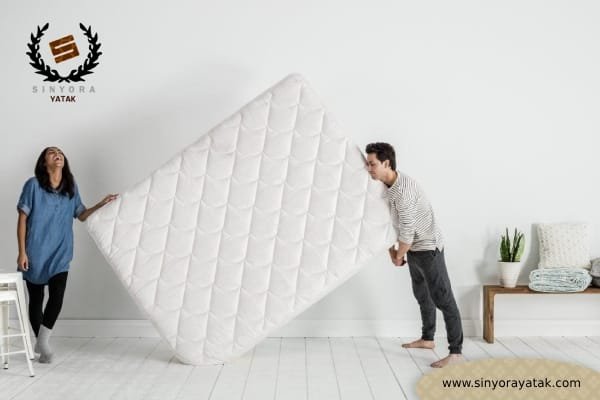Choosing the right mattress can be a daunting task, especially for couples. It’s not just about individual comfort but ensuring that both partners sleep well without disturbing each other. With so many available options, finding the perfect mattress can seem overwhelming. In this Ultimate Mattress Buying Guide for Couples, we’ll walk you through the essential factors couples should consider when buying a mattress, helping you make a decision that promotes restful sleep and strengthens your relationship.
Table of Contents
1. Assessing Individual Sleep Needs
Couples often have different sleep preferences and requirements. One person may prefer a firm mattress, while the other might want a softer surface. Before making a decision, it’s important for both partners to understand their individual sleep needs. Consider the following factors:
- Sleep Position: Back, side, and stomach sleepers require different levels of support. For instance, side sleepers often need softer mattresses to cushion their shoulders and hips, whereas back sleepers may prefer something medium-firm for optimal spinal alignment.
- Body Weight: A heavier individual might require a firmer mattress to prevent sagging, while a lighter person may find a soft mattress more comfortable.
- Temperature Preferences: Some people sleep hot, while others may prefer a cooler sleep environment. Certain mattresses, such as those made from memory foam, tend to retain heat, while others, like latex and hybrid options, are more breathable.
2. Choosing the Right Mattress Type

There are several types of mattresses available, each offering a different level of comfort, support, and motion isolation. Here’s a breakdown of the most common mattress types and how they benefit couples:
- Memory Foam Mattresses: Known for their excellent contouring and pressure relief, memory foam mattresses are great for couples who prioritize motion isolation. If one partner tends to move a lot at night, memory foam can prevent the other from feeling disturbed. However, memory foam tends to trap heat, which may not be suitable for hot sleepers.
- Innerspring Mattresses: Traditional innerspring mattresses use coils for support and tend to be firmer and bouncier. While they may offer good support, they can be noisy and transfer motion, making them less ideal for couples sensitive to movement.
- Latex Mattresses: Natural latex mattresses are durable, responsive, and provide a good balance of support and bounce. Latex also has excellent temperature regulation, making it a good choice for hot sleepers. Additionally, it provides a decent level of motion isolation without the “sinking” feeling of memory foam.
- Hybrid Mattresses: Hybrid mattresses combine the support of innerspring coils with the comfort of foam or latex layers. These mattresses offer a versatile solution for couples as they provide a balance of bounce, support, motion isolation, and temperature control.
3. Firmness Level: Finding the Right Balance
The firmness level of a mattress is one of the most critical factors when it comes to choosing a mattress for couples. It’s important to find a middle ground that accommodates both partners’ preferences.
- Soft: Ideal for lighter individuals and side sleepers who need extra cushioning for pressure points like the hips and shoulders.
- Medium: This is often the “goldilocks” option for couples as it provides the right mix of support and softness for most sleep positions.
- Firm: A firm mattress can offer better support for heavier individuals or stomach sleepers. However, it might not be comfortable for those who prefer a softer surface.
If both partners have drastically different firmness preferences, consider dual firmness mattresses or customizable mattresses that allow you to adjust each side to different firmness levels.
4. Motion Isolation: Preventing Sleep Disruption
One of the biggest challenges couples face is motion disturbance. When one partner moves, it can wake the other up, especially if the mattress does not have good motion isolation.
- Memory Foam and Latex: These materials excel at absorbing movement, making them the best options for couples who are light sleepers or who have different sleep schedules.
- Innerspring and Hybrid: While innerspring mattresses may offer less motion isolation, some hybrid models are designed with pocketed coils, which minimize motion transfer.
5. Edge Support: Maximizing Sleep Space
Edge support refers to how well a mattress holds up at its borders when pressure is applied. Couples tend to use the entire surface area of the mattress, and strong edge support can prevent the feeling of rolling off the bed.
- Memory Foam Mattresses: These often have weaker edge support unless reinforced, which can lead to a sinking feeling near the edges.
- Innerspring and Hybrid Mattresses: Innerspring and hybrid models tend to provide better edge support, especially those with reinforced coils along the perimeter.
Good edge support can increase the usable sleep surface, ensuring both partners have plenty of room to move around without feeling cramped.
6. Temperature Regulation: Staying Cool at Night

Overheating at night can significantly disrupt sleep, especially for couples. Choosing a mattress with good airflow and cooling properties is crucial for a comfortable night’s rest.
- Memory Foam: As mentioned earlier, memory foam tends to trap heat. However, some modern memory foam mattresses come with cooling gel or open-cell foam technology to improve breathability.
- Latex: Latex mattresses are naturally cooling due to their breathable structure and temperature-neutral properties.
- Innerspring and Hybrid: These mattresses allow for better airflow due to the coil system, making them a great option for couples who sleep hot.
If temperature regulation is a top concern, look for mattresses with cooling technology, such as gel-infused foams or phase-change materials that help maintain an optimal sleep temperature.
7. Size Matters: Choosing the Right Mattress Size
For couples, mattress size is another essential consideration. The wrong size can lead to discomfort, lack of sleep, and even relationship tension. When choosing a mattress size, it’s important to consider your bedroom space and personal preferences.
- Queen: A queen-sized mattress is 60 inches wide and 80 inches long, making it a good fit for couples who want enough space without taking up too much room in the bedroom. It’s also the most popular size for couples.
- King: A king-sized mattress is 76 inches wide and 80 inches long, providing plenty of space for couples who like to stretch out. It’s also a great choice for couples with children or pets that share the bed.
- California King: Slightly narrower but longer than a traditional king, a California king is ideal for taller couples who need extra legroom.
Choosing a larger mattress size can help couples feel more comfortable and reduce the chance of sleep disturbances, especially if one partner tends to move a lot during the night.
8. Durability and Longevity: Investing in a Quality Mattress
A mattress is an investment in your health and well-being, so it’s important to choose one that is durable and will last for years. The lifespan of a mattress depends on the materials used, how often it’s used, and how well it’s maintained.
- Memory Foam: These mattresses typically last around 7-10 years, depending on the density and quality of the foam.
- Latex: Latex mattresses are known for their durability, often lasting 10-15 years or more.
- Innerspring and Hybrid: Innerspring mattresses usually last 5-8 years, while hybrids can last around 7-10 years depending on the quality of the materials.
It’s essential to rotate your mattress regularly, use a mattress protector, and ensure proper support from a bed frame to extend the lifespan of your mattress.
9. Trial Periods and Warranties: Ensuring Satisfaction

Many mattress companies offer trial periods and warranties to ensure customer satisfaction, especially when buying online. As a couple, it’s crucial to take advantage of these offers to make sure the mattress is the right fit for both of you.
- Trial Periods: A good trial period typically lasts between 90 to 365 days. This allows you to sleep on the mattress for a few months and ensure it meets both partners’ needs.
- Warranties: A mattress warranty can range from 10 to 25 years, depending on the brand and model. Ensure that the warranty covers issues such as sagging, which can affect comfort and support over time.
10. Budget: Finding the Right Balance Between Cost and Comfort
The cost of a mattress can vary significantly depending on the materials, size, and brand. While it may be tempting to go for the cheapest option, keep in mind that a mattress is an investment in your health and well-being. Couples should consider their budget but also look for a mattress that offers value in terms of comfort, support, and durability.
- Memory Foam Mattresses: These are generally affordable, with prices ranging from $500 to $1,500 for a queen size.
- Latex and Hybrid Mattresses: These tend to be more expensive, with prices ranging from $1,000 to $2,500, but offer more durability and enhanced features like cooling technology and superior motion isolation.
Conclusion
Choosing the perfect mattress as a couple requires careful consideration of individual sleep needs, mattress types, firmness, motion isolation, and other factors. By investing in the right mattress, you can enhance both your sleep quality and your relationship, ensuring that both partners enjoy restful nights and wake up feeling refreshed.
At Sinyora Yatak, the best mattress shop in Turkey, we offer a wide range of high-quality mattresses tailored to the unique needs of couples. From memory foam to latex and hybrid mattresses, we have the perfect solution to ensure you both sleep soundly. Visit us today to find the mattress that will transform your nights!
Contact us today and get the best offer!
Read Also:



